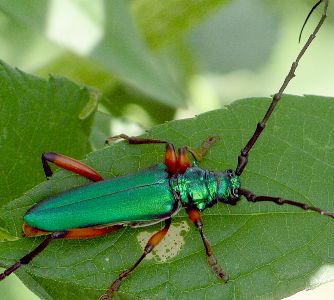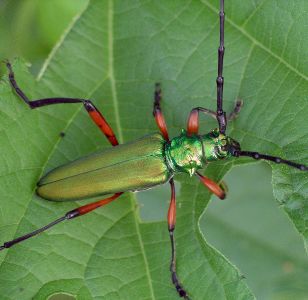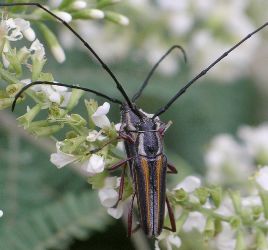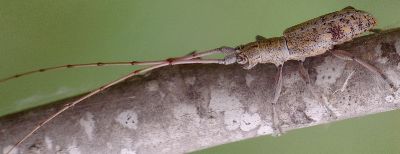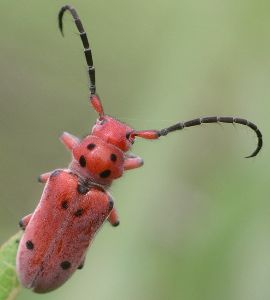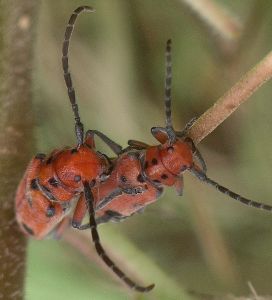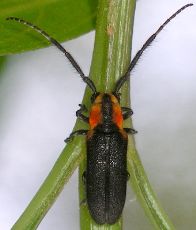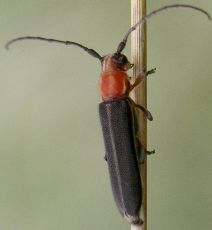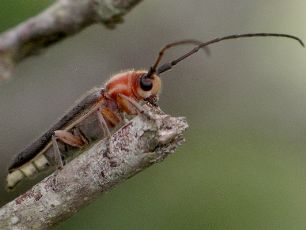
| Cerambycidae ~ Longhorn Beetles |
|
The Horsebean Longhorn (Trachyderes mandibularis) is not only easy to recognize, but its generally large size and bright colors make it pretty easy to spot. This is one species that varies a lot in size. I've seen individuals that are around 25 mm long and some that are half that. The size might be gender related. The amount of black vs. yellow is variable. The beetles feed on sap and were rather common during a wet year. The species name comes from the huge mandibles that some males possess. While these perhaps help an individual compete with other males, size of both body and jaws doesn't seem to matter too much when it comes to pairing up, as is demonstrated by the insects in the accompanying photo. The really weird thing about these two is that the small one appears to be female too, with female colored and shaped antennae. I never saw this pair actually mate, but the top one was tenacious in its grip on the other.
One of the loveliest beetles I've ever seen is the Bumelia Root Borer (Plinthocoelium suaveolens). During a very wet summer, I spotted one of these 30 mm long beetles sitting on the leaves of giant ragweed. It was so tolerant of my presence that it even returned to the same spot after flying away. That's when I realized that it had a reason to be there and a quick search in the foliage revealed what was obviously the female nearby. Since I've only seen this pair, I cannot tell if the color differences are gender related or simply variation, but in any case the species is unmistakable.
Sphaenothecus bivittata is arguably the most commonly seen longhorn in our area. It not only has a long flight period (early summer to late autumn) but also often occurs in groups where habitat is good. The females are generally discrete and sometimes hide by hugging a stem. In this posture, they look remarkably like spiders in the tetragnathidae family, which also hide in the same way. Because of the lengthy antennae, it is often difficult to estimate size on longhorns. For instance, the body length of S. bivittata is only about 12-15 mm, but the antennae may be three times that length.
The mate finding strategy of S. bivittata is rather flamboyant. Males position themselves on the highest tips of branches on flowering shrubs or small trees and keep lookout for females. Their long thin antennae wave in the wind. When females arrive, the males are quick to take action and they frequently mate while the females feed. Another subfamily of these beetles is referred to as the flat-faced longhorns (Lamiinae). This is another large group, second only to the Cerambycinae. The main feature of this subfamily is the shape of the head. When viewed from above, the most forward point is the tip of the head, between the eyes, where the antennae are attached. The mouth is only visible in a side view, and is located towards the rear of the head, giving these beetles a rather "cute" face. It reminds me of a cartoon duck with antlers.
Like the previous family, this one contains a wide variety of body shapes and sizes. One very slender striped medium-sized species with extremely long antennae is Hippopsis lemniscata. The larvae of this species feed on living ragweed and related plants and I've seen the occasional adult in gardens.
I found a pair of Dorcaschema alternatum when I saw the female laying eggs in a dead mulberry branch. The male hung around nearby. This species has yellow and gray stripes as well as blackish smudges that look like dirt, but are really their coloring. They blend in admirably with the mottled dead bark of a mulberry tree. This is one species where the antennae bases seem to cover a good portion of the eye.
Yet another striped longhorn with gray and yellow colors, is Dorcasta cinerea, which appears very late in the fall. This species has shorter, stouter and more hairy antennae than many longhorns. It holds them forward and curved down. I would not be surprised if this is a mimicry device that resembles the front legs of some spiders. The red milkweed beetles in the genus Tetraopes are easy to recognize but more difficult to place to species. As their name implies, these longhorns do feed on milkweed and can be very particular as to host species. They are around 12-13 mm long, have a fuzzy texture, and their bright red warning colors make them easy to spot. One species that I've seen occasionally is Tetraopes texana, which prefers Antelope Horns (Asclepias asperula). Besides slightly variable spots and overall color, this species sports pointed antennae tips, a good clue for identification.
The other red milkweed longhorn I've seen is still in the genus Tetraopes but species is harder to pin down. It definitely prefers Zizotes Milkweed (Asclepias oenotheroides) rather than Antelope Horns, and I've only seen it once. During a wet year, I found two mating pairs. This species differs from T. texana in the antennae not being pointed, the color being a bit more orangey, and the pronotum having a very sharply defined ridge. Otherwise, the color pattern of spots is not too different. In Tetraopes species, the eyes are completely split by the base of each antenna. Some members of this subfamily are even better firefly mimics than those of the Cerambycinae. A very small species, Hemierana marginata, looks admirably like a firefly. It measures about 6-7 mm in length and tends to hang out in vegetation where fireflies also rest during the day, such as overgrown gardens around our house. Oberea species are very long and cylindrical in shape. Oberea perspicillata also sports firefly colors. I've not seen this species very often.
The best mimic of them all is Mecas rotundicollis, which not only has the red head and pronotum combined with black body, but also has light markings on the back end of the abdomen that create an illusion of the firefly's light organ. This species appears for only a short time in June but can be rather numerous as males and females pair up to mate.
I've only seen Mecas pergrata once, but it is an easily recognized species. It is about 10 mm long, with a light fuzzy gray texture, reddish legs, a yellow stripe down the center of the elytra and black dots on the pronotum. |
![]()



